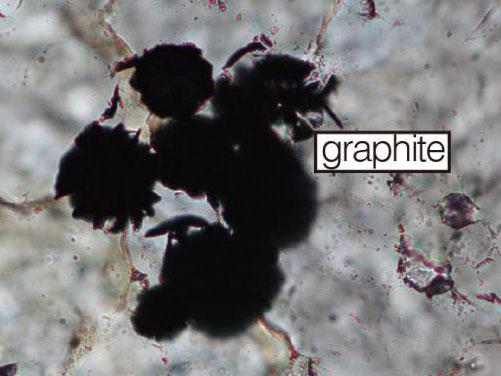The Independent's journalism is supported by our readers. When you purchase through links on our site, we may earn commission.
Life on Earth could be nearly four billion years old, suggests new fossil discovery
The Earth was an extremely hostile place at the time as it was still being bombarded by asteroids

Your support helps us to tell the story
From reproductive rights to climate change to Big Tech, The Independent is on the ground when the story is developing. Whether it's investigating the financials of Elon Musk's pro-Trump PAC or producing our latest documentary, 'The A Word', which shines a light on the American women fighting for reproductive rights, we know how important it is to parse out the facts from the messaging.
At such a critical moment in US history, we need reporters on the ground. Your donation allows us to keep sending journalists to speak to both sides of the story.
The Independent is trusted by Americans across the entire political spectrum. And unlike many other quality news outlets, we choose not to lock Americans out of our reporting and analysis with paywalls. We believe quality journalism should be available to everyone, paid for by those who can afford it.
Your support makes all the difference.Life on Earth could be nearly four billion years old, new fossil evidence suggests.
Researchers analysed rocks found in Saglek in northern Labrador, Canada, which were dated to at least 3.95 billion years ago. At that time, the Earth was still relatively young – it was formed about 4.5 billion years ago – and was probably still being bombarded by asteroids.
Tests on grains of graphite found in the sedimentary rocks found that they had been produced by living organisms, thought to be single-celled plants capable of photosynthesis.
The scientists also concluded that the graphite had been created at the same time as the rock and had not been incorporated into it at a later date.
Last year scientists unveiled fossilised stromatolites – sediments created by layer upon layer of micro-organisms – which were dated to 3.7 billion years ago. Speaking about that discovery, a Nasa expert said it showed that life was “not a fussy, reluctant and unlikely thing” but could exist in extremely hostile conditions, increasing the chances that it would be found on Mars or other parts of our solar system.
And, writing in the journal Nature, researchers in Japan said the “discovery of the biogenic graphite … will provide insight into early life not only on Earth but also on other planets”.
“The presence of life on early Earth is still controversial owing to the scarcity and poor preservation of the Eoarchean [the period from about four billion to 3.6 billion years ago] records,” they wrote. “Here we report for the first time, to our knowledge, on the occurrence and geochemical characteristics of the oldest graphite.”
Rocks of this age are scarce and usually poorly preserved, making it difficult to establish the presence of the first signs of life. Sedimentary rock cannot be dated, but igneous rock that intruded into it was dated to 3.95 billion years, making this a minimum date.
The researchers pointed out that other rock formations of a similar age from Akilia, Greenland, and Nuvvuagittuq, Canada, had not showed signs of biologically produced graphite. They found graphite in 54 out of 156 samples of sedimentary rock taken from the Saglek area.
Twenty-eight rocks with higher levels of graphite were then crushed, treated with acid and kept at 60C for several days. They were then washed with pure water, freeze-dried and then burned in oxygen at a temperature of 1,100C.
The scientists then analysed the different carbon isotopes present and concluded this showed that graphite produced by some kind of life was present.
Dr Mark Sutton, a palaeontologist at Imperial College London, said there had been claims of evidence of life from even earlier in Earth’s history, but these were “more or less disputed”.
“This would probably be the oldest convincing [evidence of life] ... I think the evidence itself is reasonably convincing,” he said. hj”If it was a modern rock you would be pretty confident it was biogenic. It sounds like they are reasonably confident this is evidence of biogenic stuff.
“This takes you back into the late ‘heavy bombardment’ times [by asteroids].”
Some researchers believe this period would have been so hostile, with the surface of the Earth still mostly molten, that no life would be possible.
Dr Sutton said the exact dates of the asteroid bombardment and how bad it would have been were open to question but “it would certainly have made life difficult”.
The rocks studied showed no signs of having been formed in an extreme situation.
“They are normal sedimentary rocks [made from] mud at the bottom of the sea or a lack in a normalish sort of environment ... there’s no evidence that the environment was particularly hostile,” Dr Sutton said.
The discovery has two implications for the search for extra-terrestrial life. One is that the earlier life is found to have begun on Earth, the more likely it is that it will be found elsewhere.
The other is that it increases the amount of time it took for complex life and intelligent life to form on Earth, which might mean that is a relatively rare occurrence – although little can be deduced from a sample size of one
It is thought photosynthesising life would have arisen after a more primitive form, which if correct would push the date of the origin of life on Earth back further. “It looks like they [life-forms] arose pretty much as soon as they could,” Dr Sutton said.
Join our commenting forum
Join thought-provoking conversations, follow other Independent readers and see their replies
Comments